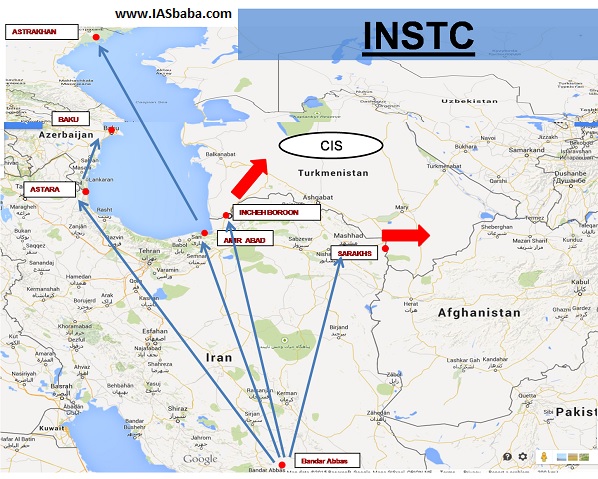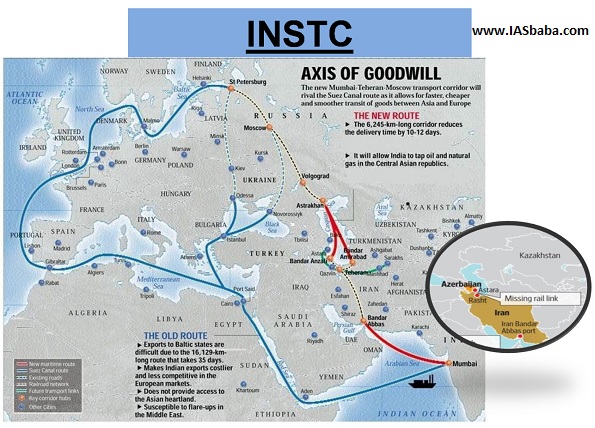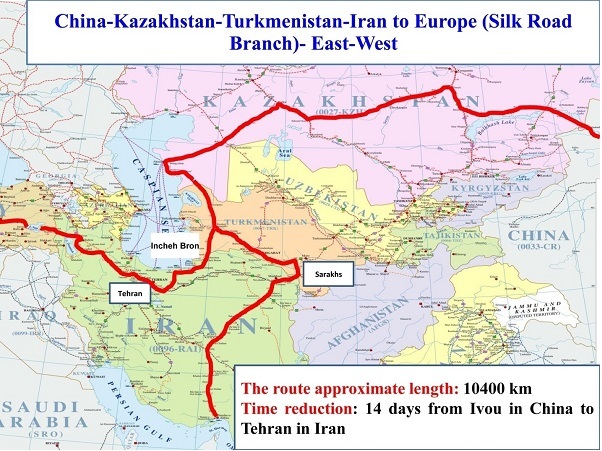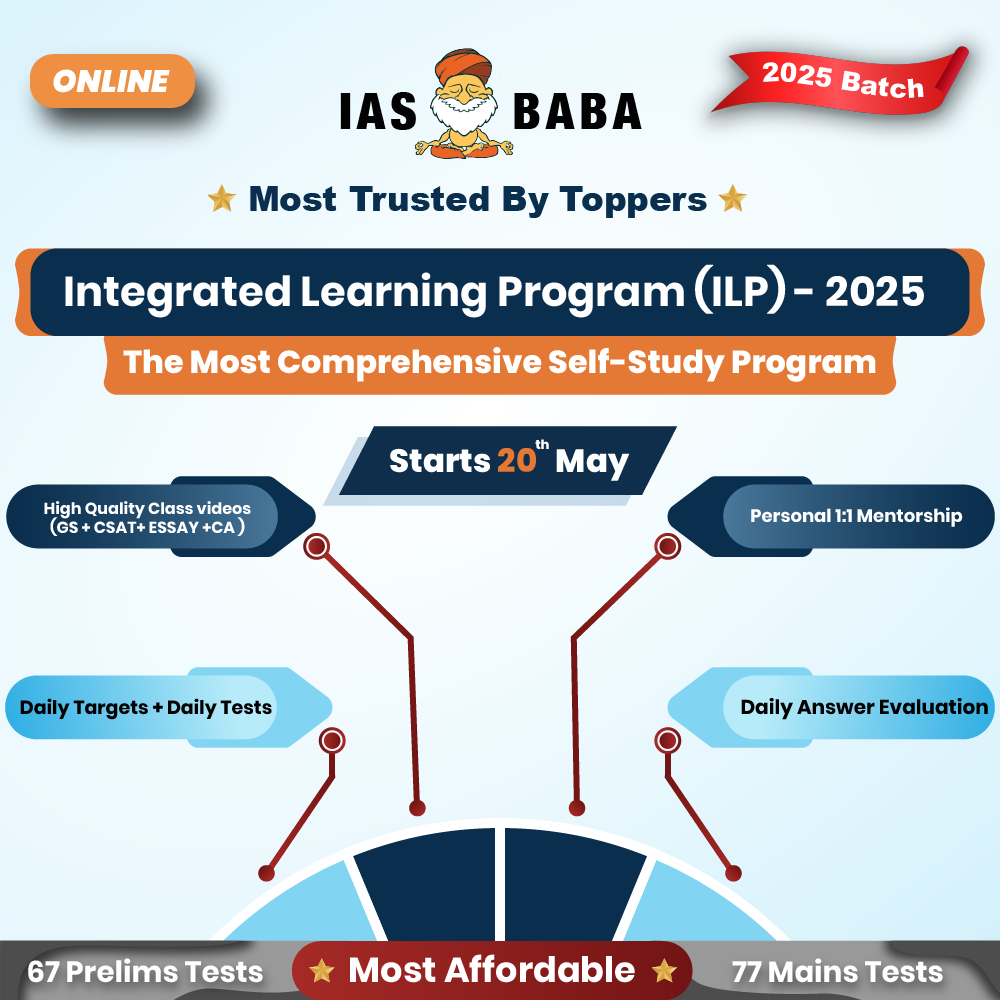IASbaba's Daily Current Affairs Analysis, IASbaba's Daily Current Affairs Oct 2016, International, National, UPSC
Archives
IASbaba’s Daily Current Affairs – 25th October, 2016
NATIONAL
TOPIC:
General Studies 2
- Government policies and interventions for development in various sectors and issues arising out of their design and implementation.
- Issues relating to development and management of Social Sector/Services relating to Health, Education, Human Resources.
General Studies 3
- Indian Economy and issues relating to planning, mobilization of resources, growth, development and employment.
- Effects of liberalization on the economy, changes in industrial policy and their effects on industrial growth.
Need for Industrial Revolution in India
- In early 2016, the Economic report of the President (US) highlighted the threat from automation to lesser skilled occupations in manufacturing and services.
- Resounding the same threat, the recently released World Development Report by the World Bank said that up to 69% of existing jobs in India are under threat from automation.
- When looked in a macro views, this is not just about displacement of existing occupations but also puts to test the development model of Asian economy.
- The Asian economy which now tries to establish its foothold at centre of global economy had been in the peripheral due to technological change and colonisation.
- Now, once again with growth of automation in the western world, the Asian model of development might experience wobble to its position in global economy.
Asia is again at disadvantageous position
- The Asian model of development was on the basis of state-supported industrialisation. It focussed on export orientation by using lower production costs as a competitive edge.
- The lower production costs were possible because of the lower labour costs in the early stages and increases in labour productivity later on.
- Along the East Asia, this model with state and region specific variations was successful.
- But now, the increasing innovation and dependence on automation will again shift in the favour of owners of intellectual capital and technology which comes from the western countries. Here, there will be diminishing returns to the labour in developing countries with onset of automation. (Meaning: Adding more labour will at some point of time yield lower per-unit returns.)
- Thus, this will be disadvantageous to countries like India in Asia, which has large, young working population.
India will need new industrial policy
- India will need an updated policy, Industrial policy 4.0, to align itself to new paradigm of industrialisation. India cannot afford to have business as usual it is more labour based industrialisation.
- If so happens, India will be demoted back to a peripheral position in the global economy with a large segment of its population unemployable or under-employed in the new economic context.
- This might lead to terrible socio-economic and political implications.
- Thus, it is important to keep the inevitable transformation in mind and create an appropriate policy which shall be capable of minimising the negative effect of automation. For this, the industry needs to create competitive opportunities for employment which would require massive resource mobilisation focused on developing the ability of the working population to absorb new skills.
- The new industrial policy will require investment in high-quality skills related to applied science and technology, engineering, quantitative and social analysis, design and product development.
- The shopfloor activities will be still done by humans who would require high familiarity with technology and analytical abilities. Hence, the workers would need to have educational levels currently available to college graduates and advanced industrial training institutes.
- This means that the industrial policy is closely linked to educational policy.
Education as industrial policy
- India is aware of the abysmal state of its educational standards and quality, especially the higher education system.
- The primary education has received full focus of the government but after that in higher education, much has been left to situations. This has made the Indian higher education perform poorly as well as creation of inadequate infrastructure. Few stats are mentioned:
- Industrial training (mostly basic and outdated) creates only 1.7 million graduates annually.
- In next three decades, over 300 million new workers are expected to be added. In that comparison, the industrial training is appallingly low.
- There are around 7 million graduates every year from social and natural sciences. It is unfortunate that many of them come from poorly run state universities and also, most of them lack applied skills.
- It has been observed that institutional expenditure in universities is largely dominated by staff salaries and maintenance (85%).
- This leaves very little for investment in research and advanced learning modules (5%). This has given rise to culture of mediocrity and low adaptation to change.
- Major tech firms re-train over 80% of their fresh engineering recruits. Now, this re-training which is largely for ‘low-skill’ jobs are expected to be overtaken by automation!
- In such a scenario, the quality of teaching required for inculcating Industrialisation can be safely assumed to be absent.
- Thus, in this condition, if there is no updated industrial policy, India is set to lose its economic growth run.
Conclusion- Need for change
- There is now a requirement of unflinching political will which will be able to radically alter the existing apparatus of skilling and higher education.
- Education is a state subject, hence, a political consensus is a critical challenge. The action plan for tackling the educational and training challenge will be a long and painful process as huge resource mobilisation will take place.
- Hence, it is difficult but inevitable to bring in together multiple stakeholders of educational sector who don’t have vested interests within the teaching and academic community and rather look forward to work for a larger goal.
- Hence, it requires important interventions like
- Private Sector involvement
- Financing the curriculum- innovative ways will be required to finance the development of advanced curriculum
- Integration with industrial and applied training
- Sustainable pool of next-gen teachers and trainers.
- Combination of ICT-based training with regular classroom teaching and on-the-job training and creating balance between them.
- Each of the intervention will require mission-mode initiatives. Interventions like ICT based training will need global best practices and thus the industry has to be on board on framing educational policy.
- The Skill India programme is good start for the government but it will not be sufficient for the enormity and complexity of the industrialisation issues. It has to be understood that skilling people and educational reforms are two separate initiatives with little actual overlap. Skill India scheme wont solve the poor education standards.
- Thus, the first step is recognising the enormity of the challenge, second is to integrate the industrial development and available financing options and then re-designing them with a skilling and higher education focus. This would lead to formation of various action plans.
- The ministry of finance and Ministry of human resource development should start a dialogue on developing the roadmap for an Industrial Policy 4.0 because the new industrial policy will be focussed on making Indian human resources ready for the next level of industrialisation.
- This is a long and difficult path but if not taken, there is a risk of not being able to maintain the economic growth in the country and after automation takes over manpower jobs, India might suffer once again from under-development and under-employment.
Connecting the dots:
- What is automation? Is it a threat to developing countries? Critically examine.
- Technologies like Automation, artificial intelligence are slowly taking over human jobs. Is this an alarming situation? What should be done to prevent robots from ruining human lives and livelihood? Discuss.
INTERNATIONAL
TOPIC: General Studies 3
- India and its neighborhood – relations
- Bilateral, regional and global groupings and agreements involving India and/or affecting India’s interests, India’s interests
- Effect of policies and politics of developed and developing countries on India’s interests, Indian diaspora
- Important international institutions, agencies and fora- their structure, mandate
International North-South Transit Corridor (INSTC)
Transit Corridors
Iran’s geographical location and proximity to India, make it an ideal transit hub for reaching Russia and CIS countries. The country is politically stable. It is also a fast growing economy. Its GDP is expected to grow by 5 % this year. Lifting of sanctions has made it easier to do business with Iran.
There are multiple axes along which International North-South Transit Corridor runs northwards from Bandar Abbas port. (Locate these ports and places in your Atlas)
- Amirabad port on the Caspian Sea, and Inchebarun crossing on Iran’s land border with Turkmenistan, are connected by rail-road to Bandar Abbas.
- Inchebarun railway crossing was inaugurated by Presidents of Kazakhstan, Turkmenistan and Iran in December 2014.
- Bandar Abbas is connected with Astara port on the western fringe of Iran’s Caspian sea-shore by road; the railway line has a gap between Rasht and Astara.
- There is rail connectivity between Bandar Abbas and Mashad, and Sarakhs, in the north east on Iran’s border with Turkmenistan. Thus considerable infra-structure already exists.
Do you know?
In 2014, a trial run was also conducted by Federation of Freight Forwarder’s Association of India (FFFAI) under the aegis of Department of Commerce, GOI. Two containers were sent north to Astara port and Amirabad port from Bandar Abbas by road.
Iran’s Caspian Sea ports of Astara, Bandar Anzali and Amirabad are connected with the Russian port of Astarakhan. There is a railway line from Astarakhan to Moscow. This route will save an estimated 40 % in time, and 30 % in cost over the traditional route from India, which goes around Europe to St. Petersberg and Moscow.
Iranian ports are similarly connected with Kazakhstan port of Aktau. Kazakhstan participated in development of Amirabad port in Iran as an outlet for its wheat exports.
Economic importance of INSTC
According to a study done by Federation of Freight Forwarders Association of India (FFFAI), INSTC will reduce the distance from JNPT port in Mumbai to Moscow via current route from 8,700 nautical miles to 2,200 nautical miles and 3000 km (over-land).
In terms of cost, this will reduce the freight cost of a 20 feet container from USD 1400 to USD 1250. The transit time will be reduced from 32 -37 days to 19 days.
INSTC will also bring enormous saving in time, and cost, for transit to CIS countries through Iran. (Existing routes either go eastward to China and then loop back westward to CIS countries. The alternate route through Georgian port of Poti is also too long.)
Absence of a direct route is one of the factors behind the rather small trade volume between India and CIS countries.
- Russian and CIS economies together have GDP of more than 1.6 trillion dollars.
- Global imports of CIS countries from all sources exceed USD 67 billion.
- India’s share in their total import basket is a miniscule USD 362.5 million or 0.54 %. In case of Russia, while its global imports are USD 193 billion, imports from India account for only USD 1.587 billion or 0.82 %.
- The break-up is given in the table below:
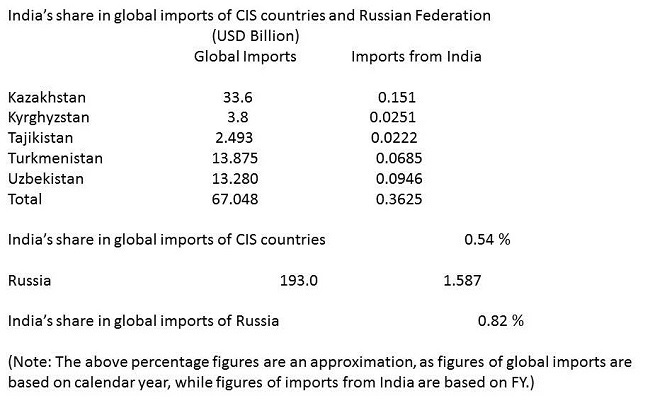
Transit Trade
Transit trade continued during the sanctions period; there were no sanctions on the transit trade per se. Exports routed through Dubai accounted for much of the north bound traffic through Iranian ports on the Caspian. Bandar Anzali also receives machinery, wood and steel from Russia.
Iran is also being used as a transit hub by member States of Economic Co-operation Organisation (ECO). This is a regional grouping of countries. This includes trade along east –west axis from Turkey to Pakistan and CIS countries. Ashgabad Agreement signed between Iran, Oman, Uzbekistan, Turkmenistan and Kazakhstan will also contribute to increasing transit trade.
However, the volume of transit trade through Iran is low. (Transit trade through Iranian ports was 7.4 % and 7.09 % of the total traffic). It should pick up as insurance, banking and shipping arrangements are normalized following lifting of sanctions.
Iran after the Sanctions
Lifting of sanctions should make it easier to do business with Iran. This will boost transit trade as well.
Payment for Iranian leg of the transit, and insurance, were problems during the sanctions period. These issues can be resolved now that sanctions have been lifted.
This will make it possible to have single set of documents for the entire journey from India to Russia or CIS countries. Direct payments will bring down transaction cost.
- International North South Transit Corridor begins in Iran.
- Iran is a stable country, and has fast growing economy.
- According to Economist Intelligence (EIU) report of August, 2016, Iran is expected to record the fastest growth in the Middle East and North Africa from 2016 till 2020.
- This year, Iran’s GDP is expected to grow by 5 % despite low oil prices. Iran has trade surplus as well as current account surplus.
Recent OPEC meeting in Algiers exempted Iran, Libya and Nigeria from production cut, while agreeing to overall reduction in OPEC ceiling. The Iranian government plans to recover its share of crude production in OPEC of more than 4 million barrels a day.
While oil export constitute a major share of Iran Government’s revenue, its dependence on oil revenues is less than other countries in the region. It is a diversified economy.
Banking channels with Iran are opening up. Already, number of EU banks have resumed operations with Iran. While US dollar payments are not possible under the US sanctions, there is no sanction on payment in Euro, Japanese Yen, Swiss Franc or any other currency.
Chabahar
While Bandar Abbas port is the main port serving International North South Transit Corridor, Chabahar port could also be linked to this route, once Chabahar-Zahedan rail line is built. Zahedan is linked to Baff railway junction to the west, which is connected with Bandar Abbas in the south, and Mashad and Sarakhs in the north east of Iran.
An MOU was signed by IRCON during PM Modi’s visit to Iran for building this sector of the railway line.
It is preferable that the entire Chabahar-Zahedan-Mashad rail corridor is completed. This will provide a direct, and shorter, access to northern Iran, than Zahedan-Baff-Mashad railway line. Mashad is already connected to Sarakh on Iran-Turkmenistan border. Once the goods reach Turkmenistan, they can move into Central Asia, which has a very well developed railway system.
One Belt One Road (OBOR)
Iran is discussing projects under ‘One Belt One Road’ initiative. China has already built a 6,000 km railway line from Eastern China to northern Iran. To the extent, OBOR contributes to building infra-structure, it will facilitate trade. There should be no conflict between OBOR and INSTC. The two could be mutually complementary. Traffic flowing along INSTC can use OBOR infra-structure and vice-versa.
Way Forward
There is a need to improve infrastructure within Iran to boost transit trade. This will involve completing Rasht-Astara railway line. This will also require upgrading Bandar Abbas – Amirabad and Bandar Abbas-Inchebarun rail corridor.
To make full use of International North-South Transit Corridor, India would also need to sign TIR (Transport Internationaux Routier) and COTIF (convention concerning international carriage by rail). These are conventions regulating road and rail traffic.
There is a need to increase shipping lines operating directly between Indian ports and Iran. Shipping Corporation of India (SCI) should start a direct shipping line. This is needed particularly for Chabahar port, which does not have any regular shipping line.
During PM Modi’s visit to Iran, financing to the tune of USD 1.6 billion was promised for Chabahar-Zahedan railway line. This commitment has to be followed with negotiation, and implementation, on the ground. Eventually, the railway line will need to be extended to Mashad also.
Trade routes bring development. Improved connectivity will benefit all countries of the region.
In short, it is time for India to put more weight on the effective implementation of its Connect Central Asia policy through appropriate institutional mechanisms. This will improve its political and economic partnerships with Central Asia countries, including Afghanistan, and will strengthen its connectivity with Eurasian economies. To achieve the goal of this policy, India should establish an India-Central Asia Forum along the lines of the India-Africa Forum.
India needs to get more proactive in exploiting opportunities to explore new markets and expand its trade with Eurasia and Central Asia.
Connecting the dots:
- Discuss the strategic significance of International North- South Transport Corridor (INSTC) for India. What are the prospects and bottlenecks for India in achieving the fruits of INSTC?
- What is the North-South Transport Corridor? What significance does it hold for India economically and geo-strategically?
MUST READ
The perils of plastic
Bird flu and what we must do
Postcards of change- India- Myanmar relation
Double-talk on free speech
Family politics playbook
The expansion of Sinosphere
The Kigali Breakthrough
Kerala is a warning about political violence in India
Afghanistan and South Asian security
The relevance of the ‘New Urban Agenda’
The crisis of farmer politics
Keep the army out of politics of blackmail



